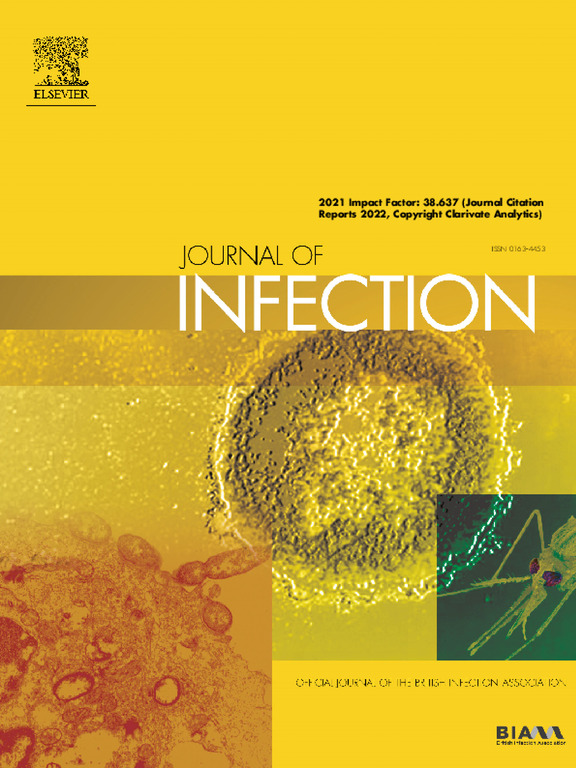HIV status and the risk of typhoid fever and iNTS: A systematic review and meta-analysis
IF 11.9
1区 医学
Q1 INFECTIOUS DISEASES
引用次数: 0
Abstract
Objectives
The WHO recommends prioritising people living with HIV (PLHIV) for typhoid vaccination, but evidence for increased typhoid fever risk is inconsistent. We aimed to evaluate whether HIV infection alters the risk of blood culture-confirmed typhoid fever.
Methods
We systematically searched four databases from inception to 30 November 2023 for studies reporting Salmonella Typhi bacteraemia with documented HIV status. Where available, we also extracted data on invasive non-typhoidal Salmonella (iNTS) bacteraemia. We used random-effects meta-analysis to pool odds ratios (ORs) and assessed effect modification by ART era, age, and CD4 count.
Results
Seventeen studies met inclusion criteria, comprising 10,117 PLHIV and 53,289 HIV-negative individuals from Africa and Asia. PLHIV had lower odds of typhoid fever (OR 0.53, 95% CI 0.30–0.92), but higher odds of iNTS disease (OR 4.06, 2.23–7.39). Apparent protection against typhoid was most evident in adults with CD4 counts <200 cells/µl and was not significant after ART rollout.
Conclusions
Advanced HIV infection may reduce the risk of typhoid fever. While altered clinical presentations or healthcare-seeking behaviours could contribute, the contrasting increase in iNTS risk within the same populations suggests a genuine difference in susceptibility. These findings support re-evaluating WHO guidance that prioritises PLHIV for typhoid vaccination.
HIV状况与伤寒和iNTS的风险:一项系统回顾和荟萃分析。
目的:世卫组织建议优先为艾滋病毒感染者(PLHIV)接种伤寒疫苗,但有关伤寒风险增加的证据并不一致。我们的目的是评估HIV感染是否会改变血培养证实的伤寒的风险。方法:我们系统地检索了四个数据库,从建立到2023年11月30日,报告伤寒沙门菌血症并记录HIV状态的研究。在可能的情况下,我们还提取了侵袭性非伤寒沙门氏菌(iNTS)菌血症的数据。我们使用随机效应荟萃分析来汇总优势比(or),并评估ART时代、年龄和CD4计数对效果的影响。结果:17项研究符合纳入标准,包括来自非洲和亚洲的10,117名PLHIV和53,289名hiv阴性个体。PLHIV感染的伤寒发生率较低(OR 0.53, 95% CI 0.30-0.92),但iNTS疾病的发生率较高(OR 4.06, 2.23-7.39)。结论:晚期HIV感染可降低伤寒的发病风险。虽然临床表现或就医行为的改变可能有所贡献,但在相同人群中,iNTS风险的对比增加表明易感性存在真正的差异。这些发现支持重新评估世卫组织的指导,该指导将艾滋病毒作为伤寒疫苗接种的重点。
本文章由计算机程序翻译,如有差异,请以英文原文为准。
求助全文
约1分钟内获得全文
求助全文
来源期刊

Journal of Infection
医学-传染病学
CiteScore
45.90
自引率
3.20%
发文量
475
审稿时长
16 days
期刊介绍:
The Journal of Infection publishes original papers on all aspects of infection - clinical, microbiological and epidemiological. The Journal seeks to bring together knowledge from all specialties involved in infection research and clinical practice, and present the best work in the ever-changing field of infection.
Each issue brings you Editorials that describe current or controversial topics of interest, high quality Reviews to keep you in touch with the latest developments in specific fields of interest, an Epidemiology section reporting studies in the hospital and the general community, and a lively correspondence section.
 求助内容:
求助内容: 应助结果提醒方式:
应助结果提醒方式:


